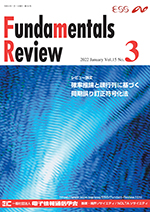Volume 15, Issue 3
Displaying 1-25 of 25 articles from this issue
- |<
- <
- 1
- >
- >|
Cover
-
2022Volume 15Issue 3 Pages 0
Published: January 01, 2022
Released on J-STAGE: January 01, 2022
Download PDF (374K)
Table of Contents
-
2022Volume 15Issue 3 Pages 150
Published: January 01, 2022
Released on J-STAGE: January 01, 2022
Download PDF (241K)
Preface
-
2022Volume 15Issue 3 Pages 151-153
Published: January 01, 2022
Released on J-STAGE: January 01, 2022
Download PDF (395K)
Advanced Review Papers
Proposed by IT (Information Theory)
-
2022Volume 15Issue 3 Pages 154-167
Published: January 01, 2022
Released on J-STAGE: January 01, 2022
Download PDF (3201K)
Review Papers
Proposed by VLD (VLSI Design Technologies)
-
2022Volume 15Issue 3 Pages 168-180
Published: January 01, 2022
Released on J-STAGE: January 01, 2022
Download PDF (2663K)
Proposed by US (Ultrasonics)
-
2022Volume 15Issue 3 Pages 181-190
Published: January 01, 2022
Released on J-STAGE: January 01, 2022
Download PDF (2951K)
Proposed by IMQ (Image Media Quality)
-
2022Volume 15Issue 3 Pages 191-198
Published: January 01, 2022
Released on J-STAGE: January 01, 2022
Download PDF (3167K)
Proposed by RCC (Reliable Communication and Control)
-
2022Volume 15Issue 3 Pages 199-209
Published: January 01, 2022
Released on J-STAGE: January 01, 2022
Download PDF (2858K)
Proposed by ITS (Intelligent Transport Systems Technology)
-
2022Volume 15Issue 3 Pages 210-219
Published: January 01, 2022
Released on J-STAGE: January 01, 2022
Download PDF (1785K)
Proposed by ICTSSL (Information and Communication Technologies for Safe and Secure Life)
-
2022Volume 15Issue 3 Pages 220-232
Published: January 01, 2022
Released on J-STAGE: January 01, 2022
Download PDF (3428K)
Miscellaneous Articles
ESS News
-
2022Volume 15Issue 3 Pages 233
Published: January 01, 2022
Released on J-STAGE: January 01, 2022
Download PDF (119K) -
2022Volume 15Issue 3 Pages 234-237
Published: January 01, 2022
Released on J-STAGE: January 01, 2022
Download PDF (478K)
Let's go to IEICE Workshops!
-
2022Volume 15Issue 3 Pages 238
Published: January 01, 2022
Released on J-STAGE: January 01, 2022
Download PDF (198K) -
2022Volume 15Issue 3 Pages 238b-239
Published: January 01, 2022
Released on J-STAGE: January 01, 2022
Download PDF (445K) -
2022Volume 15Issue 3 Pages 239
Published: January 01, 2022
Released on J-STAGE: January 01, 2022
Download PDF (384K) -
2022Volume 15Issue 3 Pages 240
Published: January 01, 2022
Released on J-STAGE: January 01, 2022
Download PDF (175K) -
2022Volume 15Issue 3 Pages 240b-241
Published: January 01, 2022
Released on J-STAGE: January 01, 2022
Download PDF (238K) -
2022Volume 15Issue 3 Pages 241
Published: January 01, 2022
Released on J-STAGE: January 01, 2022
Download PDF (199K) -
2022Volume 15Issue 3 Pages 241b-242
Published: January 01, 2022
Released on J-STAGE: January 01, 2022
Download PDF (235K)
International Conference Report
-
2022Volume 15Issue 3 Pages 243-244
Published: January 01, 2022
Released on J-STAGE: January 01, 2022
Download PDF (473K)
Niigata University Report
-
2022Volume 15Issue 3 Pages 245-246
Published: January 01, 2022
Released on J-STAGE: January 01, 2022
Download PDF (554K)
Winners' Voice
-
2022Volume 15Issue 3 Pages 247-248
Published: January 01, 2022
Released on J-STAGE: January 01, 2022
Download PDF (409K)
Call for Participations
-
2022Volume 15Issue 3 Pages 249-251
Published: January 01, 2022
Released on J-STAGE: January 01, 2022
Download PDF (1456K)
Call for Papers
-
2022Volume 15Issue 3 Pages 252
Published: January 01, 2022
Released on J-STAGE: January 01, 2022
Download PDF (1982K)
Committees & Editors Notes
-
2022Volume 15Issue 3 Pages 253-255
Published: January 01, 2022
Released on J-STAGE: January 01, 2022
Download PDF (331K)
- |<
- <
- 1
- >
- >|
